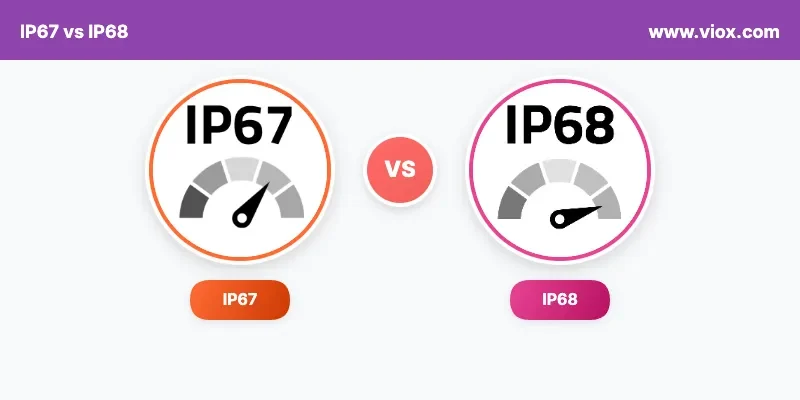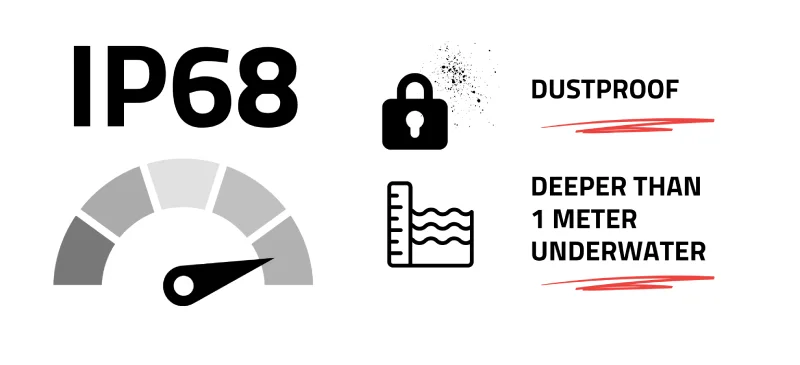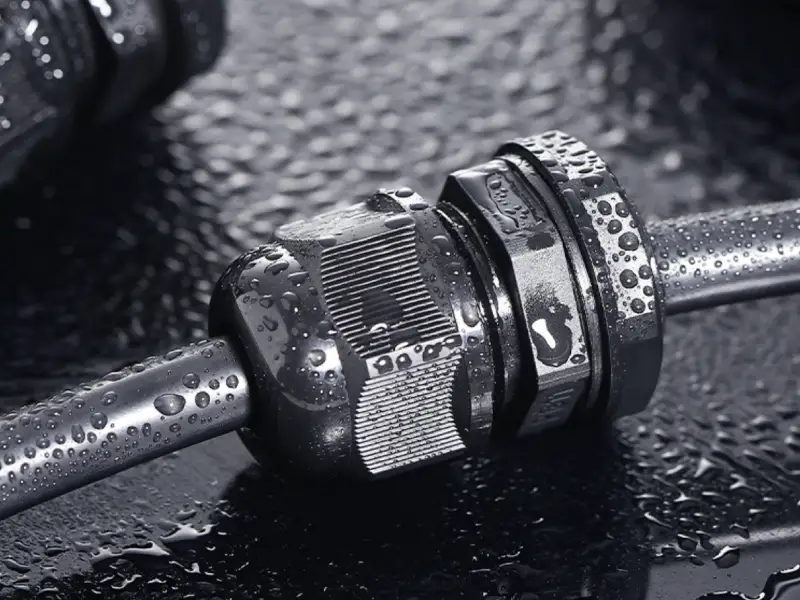IP67 and IP68 are both waterproof ratings, but IP68 offers superior water protection. IP67 devices can withstand immersion in water up to 1 meter for 30 minutes, while IP68 devices can handle deeper water and longer submersion times as specified by the manufacturer. Both ratings provide complete dust protection.
Understanding these ingress protection standards is crucial when selecting electronics for outdoor use, industrial applications, or water-exposed environments. The right IP rating ensures your equipment performs reliably while preventing costly damage from water and dust ingress.
What Are IP Ratings? Essential Definitions

Ingress Protection (IP) ratings are international standards defined by IEC 60529 that classify the degree of protection provided by electrical enclosures against intrusion of solid objects and liquids.
The IP rating consists of two digits:
- First digit (0-6): Protection against solid particles and dust
- Second digit (0-9): Protection against water ingress
IP67 Definition
IP67 rating means the device is completely dust-tight (6) and can withstand immersion in water up to 1 meter deep for up to 30 minutes (7).
IP68 Definition
IP68 rating means the device is completely dust-tight (6) and can withstand continuous immersion in water beyond 1 meter depth (8), with specific conditions defined by the manufacturer.
IP67 vs IP68: Key Differences Comparison
| Feature | IP67 | IP68 |
|---|---|---|
| Dust Protection | Complete protection (Level 6) | Complete protection (Level 6) |
| Water Depth | Up to 1 meter | Beyond 1 meter (manufacturer specified) |
| Immersion Time | Maximum 30 minutes | Continuous (manufacturer specified) |
| Typical Applications | Smartphones, outdoor cameras | Diving equipment, submarines |
| Cost Factor | Lower manufacturing cost | Higher manufacturing cost |
| Testing Standard | IEC 60529 standardized | IEC 60529 + manufacturer specifications |
| Common Depths | 0.15m to 1m testing | 1.5m to 10m+ depending on design |
Detailed Water Protection Analysis
IP67 Water Protection Specifications
IP67 devices undergo standardized testing under these conditions:
- Test duration: 30 minutes maximum
- Water depth: 0.15 meters to 1 meter
- Water temperature: Room temperature
- Test method: Static immersion without water circulation
⚠️ Safety Note: IP67 rating does not guarantee protection against high-pressure water jets or dynamic water conditions.
IP68 Water Protection Specifications
IP68 testing varies by manufacturer but typically includes:
- Test duration: Continuous immersion (hours to days)
- Water depth: 1.5 meters to 10+ meters
- Pressure resistance: Significantly higher than IP67
- Test conditions: Often include circulation and pressure simulation
Expert Tip: Always check manufacturer specifications for IP68 devices, as “IP68” alone doesn’t specify exact depth and duration limits.
Applications and Use Cases
When to Choose IP67
IP67 is ideal for:
- Smartphones and tablets for everyday water resistance
- Outdoor security cameras in normal weather conditions
- Industrial sensors in mildly wet environments
- Automotive electronics exposed to rain and washing
- Consumer electronics for pool-side or beach use
When to Choose IP68
IP68 is essential for:
- Underwater photography equipment
- Marine navigation instruments
- Swimming pool lighting systems
- Submersible pumps and sensors
- Professional diving equipment
- Underwater drones and ROVs
Industry Applications Breakdown
Consumer Electronics
- Smartphones: Most flagship phones now offer IP67 or IP68
- Smartwatches: Swimming-focused models typically use IP68
- Action cameras: Professional models often exceed basic IP68 standards
Industrial Applications
- Process control sensors: IP68 for submerged monitoring
- Outdoor networking equipment: IP67 sufficient for weather protection
- Marine instruments: IP68 mandatory for continuous submersion
Automotive Industry
- Engine bay sensors: IP67 standard for normal operations
- Underwater vehicle systems: Custom IP68+ ratings required
Selection Criteria: How to Choose the Right Rating
Step-by-Step Selection Process
- Assess your environment
- Maximum expected water depth
- Duration of potential water exposure
- Presence of water pressure or jets
- Evaluate cost vs. benefit
- IP67 offers excellent protection for most applications
- IP68 required only when submersion exceeds IP67 limits
- Check manufacturer specifications
- Verify exact depth and time ratings for IP68
- Confirm testing standards and conditions
- Consider long-term reliability
- IP68 typically offers better seal integrity over time
- Higher initial cost may reduce replacement frequency
Expert Decision Framework
Choose IP67 when:
- Water exposure is accidental or temporary
- Budget constraints are significant
- Standard weather protection is sufficient
Choose IP68 when:
- Intentional submersion is required
- Continuous underwater operation needed
- Maximum protection is worth additional cost
Testing Standards and Certifications
IEC 60529 Standard Requirements
Both IP67 and IP68 must comply with International Electrotechnical Commission standards:
Dust Testing (First Digit – 6):
- Complete protection against dust ingress
- 8-hour test in talcum powder chamber
- No dust particles must penetrate enclosure
Water Testing Procedures:
- IP67: Immersion test at specified depths and duration
- IP68: Extended immersion with manufacturer-defined parameters
Professional Certification Process
Devices must undergo testing at accredited laboratories:
- Pre-testing preparation: Seal integrity verification
- Environmental conditioning: Temperature and humidity cycling
- Immersion testing: Following exact protocol specifications
- Post-test inspection: Internal examination for water ingress
- Documentation: Detailed test reports and certifications
Common Misconceptions and Clarifications
Myth vs. Reality
❌ Myth: “IP68 is always better than IP67”
✅ Reality: IP68 costs more and may be unnecessary for many applications
❌ Myth: “IP ratings protect against all types of water exposure”
✅ Reality: High-pressure jets and steam may penetrate even IP68 devices
❌ Myth: “IP ratings are permanent and never degrade”
✅ Reality: Seals can deteriorate over time, requiring maintenance
Troubleshooting and Maintenance
Signs of Compromised IP Protection
Watch for these warning indicators:
- Visible cracks in seals or gaskets
- Fogging inside transparent housings
- Corrosion around connection points
- Reduced performance in humid conditions
Maintenance Best Practices
- Regular seal inspection: Check gaskets every 6-12 months
- Proper cleaning: Use manufacturer-approved cleaning agents
- Temperature cycling: Avoid extreme temperature changes
- Professional servicing: Annual inspection for critical applications
⚠️ Safety Warning: Never attempt to service IP-rated enclosures without proper training and replacement seals meeting original specifications.
Cost Analysis and ROI Considerations
Price Impact Factors
| Factor | IP67 Impact | IP68 Impact |
|---|---|---|
| Manufacturing complexity | Moderate increase | Significant increase |
| Material costs | Standard sealing materials | Premium sealing systems |
| Testing requirements | Standard protocols | Extended testing needed |
| Design constraints | Moderate limitations | Significant design challenges |
Long-term Value Assessment
IP67 ROI Benefits:
- Lower initial investment
- Adequate protection for most applications
- Easier repairs and maintenance
IP68 ROI Benefits:
- Reduced replacement frequency
- Higher equipment reliability
- Expanded application possibilities
Future-Proofing and Technology Trends
Emerging Standards
The electronics industry continues advancing IP protection:
- Enhanced testing protocols for extreme environments
- Smart sealing systems with self-monitoring capabilities
- Nano-coating technologies complementing mechanical seals
Industry Evolution
Current trends affecting IP rating selection:
- Increasing consumer demand for water-resistant devices
- Stricter industrial safety requirements
- Growing marine and underwater applications
Quick Reference Guide
IP67 vs IP68 Decision Checklist
✅ Choose IP67 if:
- Water exposure limited to 1 meter depth
- Immersion time under 30 minutes
- Cost optimization is priority
- Standard weather protection needed
✅ Choose IP68 if:
- Submersion beyond 1 meter required
- Continuous underwater operation needed
- Maximum protection justifies higher cost
- Professional/industrial application
Emergency Assessment Questions
- What is the maximum water depth your device will encounter?
- How long might the device remain submerged?
- Will the device face high-pressure water exposure?
- What is your budget for protection vs. replacement costs?
Frequently Asked Questions
What is the main difference between IP67 and IP68?
The primary difference is water protection depth and duration. IP67 protects against immersion up to 1 meter for 30 minutes, while IP68 allows deeper, longer submersion as specified by the manufacturer.
Can IP67 devices be used underwater?
Yes, but only temporarily. IP67 devices can handle underwater use up to 1 meter deep for maximum 30 minutes. For extended underwater use, choose IP68.
Is IP68 always more expensive than IP67?
Generally yes. IP68 requires more sophisticated sealing systems and extensive testing, resulting in higher manufacturing costs that are passed to consumers.
Do IP ratings protect against saltwater?
Both IP67 and IP68 testing typically uses fresh water. Saltwater is more corrosive and may require additional protection measures beyond standard IP ratings.
How long do IP seals last?
Seal lifespan depends on usage conditions, but typically ranges from 2-5 years for consumer devices and 5-10 years for industrial equipment with proper maintenance.
Can I upgrade a device from IP67 to IP68?
No. IP ratings are determined by the original design and manufacturing. Retrofitting different sealing systems would require complete redesign and recertification.
What happens if water gets inside an IP-rated device?
Immediately power down the device, remove batteries if possible, and seek professional service. Water damage often voids warranties even on IP-rated devices if the damage indicates seal failure.
Are there IP ratings higher than IP68?
IP68 is the highest standard water protection rating. Some manufacturers use proprietary ratings like “IP69K” for specific high-pressure applications, but these aren’t standard classifications.
Expert Recommendations and Professional Guidance
Professional Installation Considerations
When specifying IP-rated equipment for commercial or industrial applications:
- Consult certified installers familiar with IP rating requirements
- Verify local compliance codes that may mandate specific protection levels
- Document installation procedures to maintain warranty coverage
- Plan maintenance schedules to preserve IP protection over time
When to Consult Specialists
Seek professional advice for:
- Critical safety applications where failure could cause injury
- Installations requiring compliance with specific industry standards
- Custom applications exceeding standard IP rating parameters
- High-value equipment where protection investment is justified
⚠️ Professional Recommendation: For mission-critical applications, consider IP ratings as minimum requirements and evaluate additional protective measures based on specific operational conditions.
Final Recommendation: Choose IP67 for general water resistance needs and IP68 only when specific submersion requirements justify the additional cost. Both ratings provide excellent dust protection, making your decision primarily about water exposure depth and duration requirements.
Understanding these ingress protection standards ensures you select equipment that delivers reliable performance while avoiding unnecessary costs or inadequate protection for your specific application needs.





